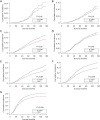Postmastectomy radiotherapy indications using pathological prognostic staging in node-positive breast cancer
- PMID: 40671775
- PMCID: PMC12261248
- DOI: 10.21037/gs-2025-84
Postmastectomy radiotherapy indications using pathological prognostic staging in node-positive breast cancer
Abstract
Background: The role of pathological prognostic staging (PPS) on postmastectomy radiotherapy (PMRT) selection remains unclear. This study aimed to investigate the impact of PPS on PMRT selection in patients with node-positive breast cancer (BC).
Methods: We included women diagnosed with BC between 2010 and 2015 from the Surveillance, Epidemiology, and End Results database. Chi-square test, operating characteristic curve, and competing-risks analyses with the Fine and Gray model were used for statistical analyses.
Results: A total of 14,830 patients were included. Overall, 8,807 (59.4%) patients received PMRT while 6,023 (40.6%) did not. Among them, 11,767 patients (79.3%) had their stage changed, with 1,086 (7.3%) upstaged and 10,681 (72.0%) downstaged. PPS had better prognostic accuracy compared with anatomical staging (AS) (P<0.001). Regarding PPS, PMRT significantly decreased 5-year breast cancer-specific mortality in patients with stage IIIA (14.4% vs. 19.7%, P<0.001), IIIB (19.8% vs. 27.2%, P=0.003), and IIIC (38.5% vs. 45.7%, P=0.049) diseases compared with those of other stages. However, no significant effects were observed in stage IA, IB, IIA, and IIB diseases.
Conclusions: Our study highlights significant staging differences between AS and PPS in patients with node-positive BC. The high rate of downstaging observed with PPS suggests its potential to enhance risk stratification and optimize treatment strategies, especially in guiding the appropriate use of PMRT.
Keywords: Breast cancer (BC); mastectomy; radiotherapy; staging; survival.
Copyright © 2025 AME Publishing Company. All rights reserved.
Conflict of interest statement
Conflicts of Interest: All authors have completed the ICMJE uniform disclosure form (available at https://gs.amegroups.com/article/view/10.21037/gs-2025-84/coif). The authors have no conflicts of interest to declare.
Figures





Similar articles
-
A nomogram to predict the benefit of postmastectomy radiotherapy in breast cancer with nodal micrometastases.Breast Cancer. 2025 Sep;32(5):935-946. doi: 10.1007/s12282-025-01717-3. Epub 2025 May 7. Breast Cancer. 2025. PMID: 40335870
-
Post-mastectomy radiotherapy for women with early breast cancer and one to three positive lymph nodes.Cochrane Database Syst Rev. 2023 Jun 16;6(6):CD014463. doi: 10.1002/14651858.CD014463.pub2. Cochrane Database Syst Rev. 2023. PMID: 37327075 Free PMC article.
-
The Predictive Effect of the 8th AJCC Pathological Prognostic Staging on the Benefit of Postmastectomy Radiotherapy in N2/N3 Breast Cancer.Breast Cancer (Dove Med Press). 2022 May 13;14:133-144. doi: 10.2147/BCTT.S362355. eCollection 2022. Breast Cancer (Dove Med Press). 2022. PMID: 35592354 Free PMC article.
-
Postmastectomy radiotherapy in patients with T1-2N1 breast cancer: a single center experience and a meta-analysis.J Cancer Res Clin Oncol. 2023 Sep;149(12):9979-9990. doi: 10.1007/s00432-023-04908-7. Epub 2023 May 31. J Cancer Res Clin Oncol. 2023. PMID: 37256383 Free PMC article.
-
Cost-effectiveness of using prognostic information to select women with breast cancer for adjuvant systemic therapy.Health Technol Assess. 2006 Sep;10(34):iii-iv, ix-xi, 1-204. doi: 10.3310/hta10340. Health Technol Assess. 2006. PMID: 16959170
References
-
- National Comprehensive Cancer Network. (NCCN) clinical practice guidelines in Oncology. Breast Cancer 2024. Version 1. Available online: https://www.nccn.org/professionals/physician_gls/pdf/breastl.pdf
LinkOut - more resources
Full Text Sources
Research Materials
